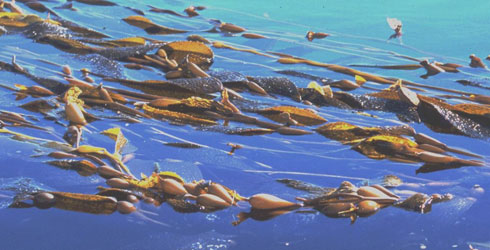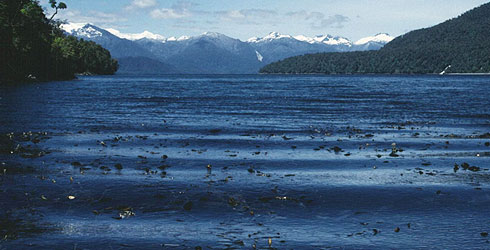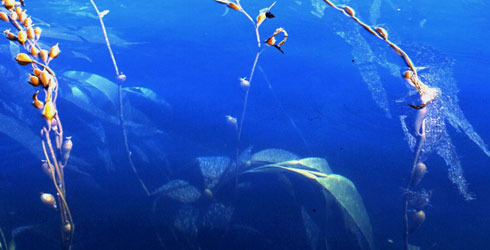Macrocystis pyrifera (giant kelp)
Macrocystis pyrifera is the largest marine alga (seaweed) in the world with its fronds sometimes exceeding 45m in length - it is sometimes referred to as the Sequoia of the sea.
The fronds are capable of growing to 45m in one season - the world’s fastest linear growth.
This kelp has root-like holdfasts, long slender stalks with leaf-like fronds buoyed by small gas-filled bladders - on the surface these spread out to form a dense subsurface canopy.
It forms dense submarine ‘forests’ on hard substrata or occasionally on coarse sand at depths less than 40m.
These forests are some of the most productive communities on earth with much of the annual production exported as large floating rafts.
Macrocystis is a commercially important seaweed. The largest mechanical harvesting took place off the coast of southern California, where 100,000 to 170,000 wet tons were harvested annually for alginate extraction and abalone feed.
The harvesting for alginates ceased in 2005, but the kelp is still harvested as feed for abalone aquaculture. Commercial operations took place in several countries, including Chile and Tasmania, but have now ceased as they are no longer economically viable.
Species detail
-

Distribution
Macrocystis pyrifera forms dense forests beneath the water surface in many parts of the world. Find out more about its habitat, and what happens when large numbers of sea urchins start grazing.
-

Biology
The kelp’s holdfasts are huge, and can survive up to 10 years. But it is the microscopic filamentous stage that is crucial for the seaweed’s survival. Find out why.
-

Behaviour
Macrocystis forests provide an important food source and habitat for hundreds of animals. Get a taste of the animals that live on this giant kelp.
-

Conservation
Grazing sea urchins can devastate Macrocystis forests. Find out what else threatens this important species.
-

References
Get reference material for Macrocystis pyrifera.
Images

The fronds and air-bladders of Macrocystis pyrifera.
© David M John
A Macrocystis plant being carried onto a beach in southern Chile by scientists at the Natural History Museum and Raleigh International Adventurers for measuring and sampling the animals associated with it.
© David M John
Floating fronds of Macrocystis pyrifera in the Golfo Elefantes, Chile with the snow-covered Andes in the background.
© David M John
Underwater view of the stipes, fronds and air-bladders of Macrocystis pyrifera.
© David M JohnAuthor
Professor David John
Scientific Associate
Department of Botany
A word from the author
"Macrocystis pyrifera, commonly known as giant kelp, is of special interest since it is the largest marine plant (and seaweed) in the world and grows in length faster than any other plant. Its submarine forests are some of the most productive in the world and contain an exceptionally high biological diversity."
Toolbox
Glossary
Abalone
Edible sea snails.
Alginates
A compound rendered from seaweed that can be used to make temporary casts.
Fronds
Leaf-like parts of the seaweed.
Holdfasts
Root-like structures that anchors the seaweed to a substrate.
Macroscopic
A size large enough to be visible with the naked eye.
Microscopic
A size so small that is only visible with a lens or microscope.
